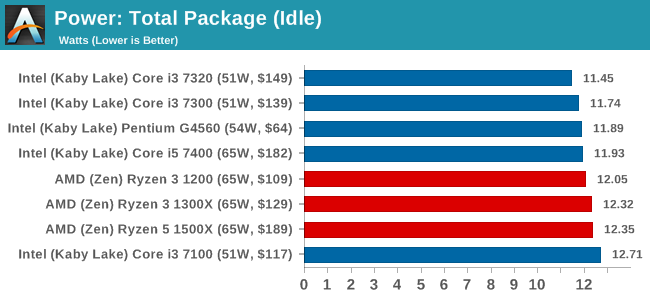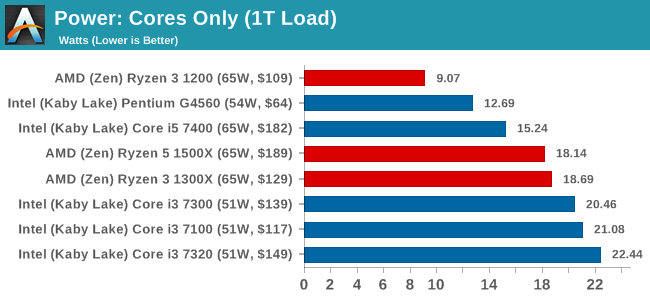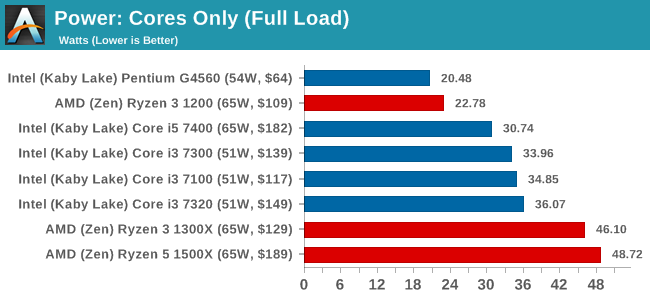The AMD Ryzen 3 1300X and Ryzen 3 1200 CPU Review: Zen on a Budget
by Ian Cutress on July 27, 2017 9:30 AM EST- Posted in
- CPUs
- AMD
- Zen
- Ryzen
- Ryzen 3
- Ryzen 3 1300X
- Ryzen 3 1200
Power Consumption
For our power consumption readings, we run a Prime 95 load and slowly ramp up the number of threads in play, taking power data from the internal CPU registers that report for when turbo modes or thermal modes should activate. Depending on the CPU access, we can get data that varies from the full package down to individual cores, uncore, integrated graphics and DRAM controllers.
For the Ryzen CPUs, the API pulls out the total package power consumption first.



At idle, all the CPUs are pretty much equivalent. The cores are fully idle here, leaving the rest of the chip active enough for tick-over. As we ramp up the load, the higher-frequency Ryzen CPUs move towards their 65W TDP, with the Ryzen 3 1300X almost being spot on at 64.2W. The Intel CPUs are clocked higher, but only have two cores to contend with. The Ryzen 3 1200 is clocked lower than the Ryzen 3 1300X, hitting a better efficiency point in the Zen design. This ultimately bodes well for upcoming quad-core SKUs in laptops.


One of the odd things about the power consumption of the Ryzen 3 CPUs is the difference between how much power the cores internally measure compared to the full power consumption of the package measured as a whole, including the Infinity Fabric, DRAM controllers, IO and such. For the Ryzen 3 1200 for example, at full load the package has a power consumption of 40.43 W total, but the cores only count for 23.05W, leaving 17.38W on the table for the non-core elements in the chip. If we compare that to the Ryzen 5 1500X, we have 68.79W for the package and 49.69W for the cores, a 19.1W difference. For the Ryzen 7 1700X, it becomes 81.51W for the package and 62.10W for the cores, a 19.4W difference.
On the high-end chips, the difference is a smaller portion of the full power consumption, but on the Ryzen 3 processors the cores are only 57% of the power consumption, leaving 43% for the rest of the chip. A lot of this power could be the inter-CCX infinity fabric path, which means that packages like EPYC are giving away a lot of power to IF. If it is more other features, it could spell a number of problems for upcoming mobile chips, limiting the lower bounds of the power consumption. Naturally, I actually want to get my hands on to an EPYC processor in my own lab to see if we can pin down what is happening here.










140 Comments
View All Comments
ampmam - Thursday, July 27, 2017 - link
Great review but biased conclusion.tvdang7 - Thursday, July 27, 2017 - link
No overclock?Oxford Guy - Thursday, July 27, 2017 - link
No, just a RAM underclock.zodiacfml - Thursday, July 27, 2017 - link
overclocking tests on the ryzen 3 1200 please. the only weakness of the chip is for non-gaming or htpc usage as it will require purchasing a discrete graphics card. otherwise, it presents good value for most things like gaming and multi-threaded applications, add overclocking, and it gets even better.kaesden - Thursday, July 27, 2017 - link
one thing to not overlook with the ryzen 1300x is the platform. Its competitive with budget intel offerings and can take a drop in 8 core 16 thread upgrade with no other changes except maybe a better cooling solution, Something intel can't match. Intel has the same "strategy" at their high end with the new X299 platform, but they seem to have lost focus of the big picture. The HEDT platform is too expensive to fit this type of scenario. Anyone who's shelling out the cash for a HEDT system isn't the type of budget user who is going to go for the 7740x. they're just going to get a higher end cpu from the start if they can afford it at all, not to mention the confusion about what features work with what cpu's and what doesn't, etc...TLDR; AMD has a winner of a platform here that will only get better as time goes on.
peevee - Thursday, July 27, 2017 - link
From the tests, looks like Razen 3 does not make much sense. Zen arch provides quite a boost from SMT in practically all applications where performance actually matters (which are all multithreaded for years now), and AMD artificially disabled this feature for that stupid Intel-like market segmentation.Also I am sure there are not that many CPUs where exactly 2 out of 4 cores on each CCX is broken. So in effect, in cases like one CCX has 4 good cores and another has only 2 they kill 2 good cores, kill half of L3, kill hyperthreading...
It would be better to create a separate 1-CCX chip for the line, which would have much higher (more that twice per wafer) yield being half the size, and release 2, 3 and 4 core CPUs as Ryzen 2, 3 and 4 accordingly. With hyperthreading and everything. I am sure it does not cost "tens of millions of dollars" to create a new mask as even completely custom chips cost less, let alone that simple derivative.
Oxford Guy - Thursday, July 27, 2017 - link
"It would be better to create a separate 1-CCX chip for the line"Or, it could be explained by this article why AMD can't release a Zen chip with 1 CCX enabled and one disabled. Instead, we just get "obviously".
silverblue - Friday, July 28, 2017 - link
He did explain it. Page 1.Oxford Guy - Saturday, July 29, 2017 - link
Where?All I see is this: "Number 3 leads to a lop-sided silicon die, and obviously wasn’t chosen."
That is not an explanation.
peevee - Tuesday, August 1, 2017 - link
That is still be half the yield per wafer compared to a dedicated 1-CCX line. Twice the cost. Cost matters.And the 3rd chip must be 1CCX+1GPU. SMT must be on everywhere though, it is too good to artificially lower value of your product by disabling it by segmentation.